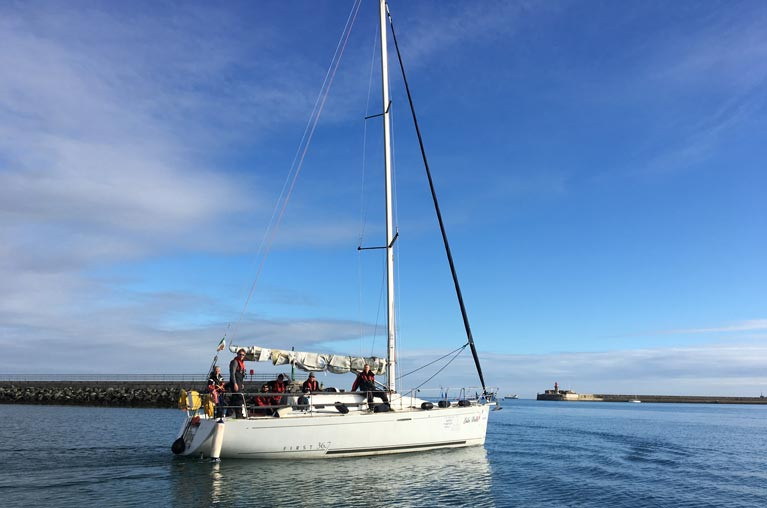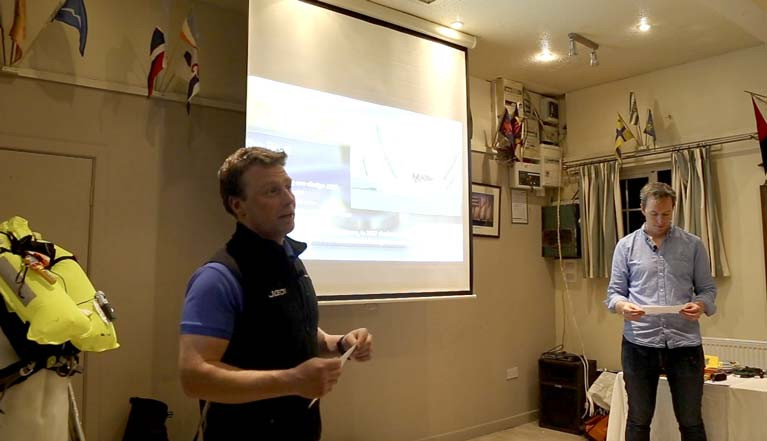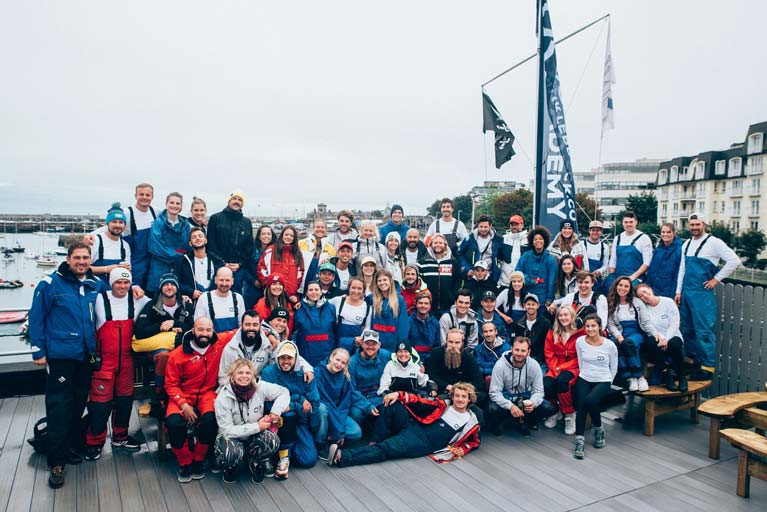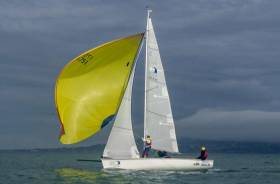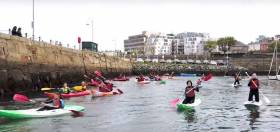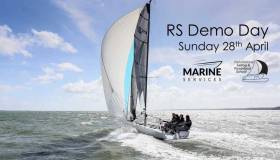Displaying items by tag: Irish National Sailing School
Irish National Sailing School Keen to Grow Irish Yacht Charter Fleet at Dun Laoghaire Harbour
The Irish National Sailing School (INSS) at Dun Laoghaire Harbour is taking the next steps to get domestic yacht charter up and running in the east coast port.
Following a survey launched earlier in April, the INSS believes that there’s sufficient demand to have a domestic charter fleet up and running for August, on into the winter and ready for the 2021 season, driven in part by a reluctance to travel abroad caused by Coronavirus.
The school is making its two yachts available, however, capacity will quickly be met in light of the demand for the boats on the training courses. So, instead, they’re hoping that owners based on the East coast will work with them, on a profit share basis, with the school managing administration, handover, dealing with any issues during the charter and receiving the boat back and ensuring it's handed back to its owner in full working order as well as being spick and span!
The school, run by Kenneth Rumball, has been in contact with insurance providers, and upgrading cover is typically a small increase on premium. The owner would receive over half of the charter fee, and schemes in operation elsewhere usually cover the yachts annual running costs. Effectively it can be viewed as free annual boating.
Starting small, Rumball details how he sees the whole concept developing “Initially, we’d like to work with two or three owners based between Dun Laoghaire and Greystones. Interest from further afield is welcome”. The school’s survey indicates that boats in the 35-45 foot range are most likely to work in the Irish market.
A prospectus is available for interested yacht owners.
Rumball is keen to chat with any prospective owners. Tel: 01 2844195 or by email directly to [email protected]
There’s a demand for short term, easily available yacht charter on Irish waters, that's according to a survey conducted earlier this month by a Dun Laoghaire Harbour Sailing School.
As Afloat reported previously, the Irish National Sailing & Powerboat School in Dun Laoghaire Harbour asked those who might usually head abroad for a charter holiday what their intentions were in light of the Covid-19 epidemic.
The main aim was to see what could be done to help the domestic marine industry and get a conversation going, with actions flowing quickly.
The concept was rooted in stimulating the domestic charter market especially as family activities on a yacht may be one of the few activities that can safely get afloat this year.
Between speaking to their previous graduates from the last few years, and with help from afloat magazine data and suggestions started coming in from a very short survey.
Over 40% of respondents indicate they would be less likely to travel overseas to charter, with more than 50% indicating they would be more likely to do so in Ireland. Commenting on the figures, Communications and Marketing Manager Glyn Williams describes them as “Hardly surprising, but being able to a figure on it is great, but equally, we got plenty of insight into what barriers there are to chartering yachts, as well as some brilliant suggestions”.
What Barriers Exist for the Irish Yacht Charter Market?
The school found that the top factor considered a barrier to chartering was the value for money proposition. Equally the yacht availability, flexibility on charter duration and the clear display of this information was raised.
"Biggest barrier to chartering was the value for money proposition"
Yacht and service quality ranked next and tied into the value for money question. According to school chief instructor Kenneth Rumball, “Undoubtedly, professional management and rapid support will deal with many of these concerns, as it’s very unlikely the Irish industry would match the age and cycling of vessels in more established charter destinations”.
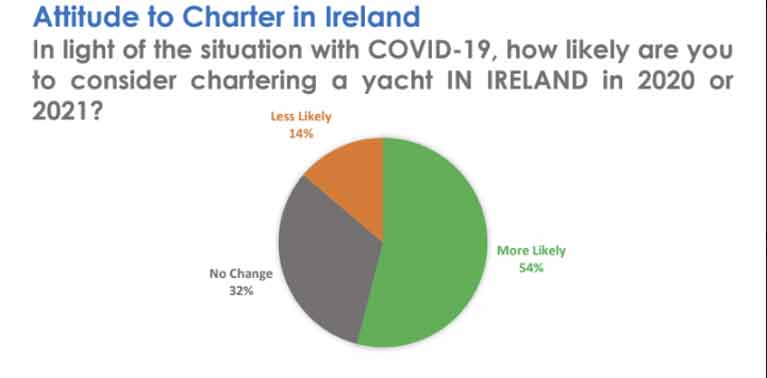 (Above and below) results from the INSS Yacht Charter survey taken during the COVID-19 epidemic
(Above and below) results from the INSS Yacht Charter survey taken during the COVID-19 epidemic
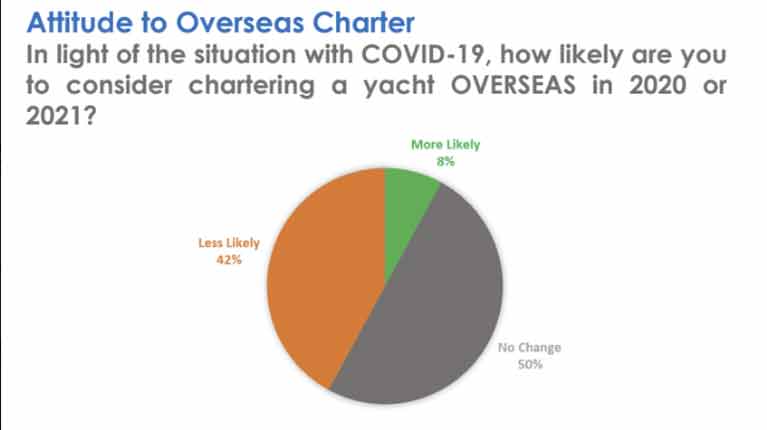
Perceptions of skipper’s own knowledge gaps was the next most common concern. We’re competing against destinations with well-established routes, excellent marina networks and more importantly, no tides. The school is well placed here to help, according to Kenneth “training is our business, this is something we propose to address with short theory courses and tailored client support”.
Interestingly, the gaps in the marina network didn’t feature as a major concern according to Glyn. “There’s a demand for short term, easy entry charter. This doesn’t take away from calls for more infrastructure development around our coast but shows that we can grow this concept with what’s already available”.
By this stage of this article, you’re probably screaming at your screen “What about the weather!”. Glyn’s response, “Well, it certainly came up, but not nearly as much as you’d have guessed. Instead, it was framed in terms of value for money and what could be offered by providers to accommodate the Irish climate”.
What’s next?
When asked about developing the concept from the school’s perspective, Kenneth is optimistic. “We train about 300 yacht graduates each year, and the vast majority do the course to access the charter lifestyle. With some clever and targeted supports, we can easily convince those to holiday at home, especially when personal skills development can be listed as a benefit alongside spending time with the family, or partner”.
Rumball feels collaboration will be important. “We’ve already got a great relationship with James Lyons from Sovereign Sailing, and we’ll continue working together behind the scenes to advance the concept”. Other interested parties are invited to get in touch with the school.
Moving forward, the school is calling for interested yacht owners who may be interested in working with the school to expand the concept on the East Coast. Profit-share arrangements work elsewhere, participating owners typically cover all annual costs, from insurance, mooring fees and ongoing maintenance. Rumball characterises it as essentially free yachting for the owner and proposes a concept where the Irish National Sailing & Powerboat School would manage bookings, administration, maintenance and all the logistics. The school has already been in contact with prospective insurers and has found premiums only typically rise around 40% to cover the charter element.
Owners can contact Kenneth Rumball by email, [email protected], or call the school’s office on 01 284 4195 for more details and a full breakdown of the proposals.
The Irish National Sailing & Powerboat School in Dun Laoghaire Harbour want to hear from those who holiday abroad on charter yachts and those who may want to. Given the travel uncertainty emanating from COVID-19 restrictions, there’s a possibility to highlight the excellent cruising and holiday options here in Ireland.
Since the sailing school re-started yachting courses five years ago the vast majority of graduates both are new, or returning to sailing, and undertook the training to charter a yacht abroad.
With travel plans less certain, and the Irish tourism sector facing a huge challenge to get back on its feet the team at the school want to help those who might otherwise have skipped a sailing holiday do so in Ireland when it is safe to do so again.
 The INSS has put together a two-minute survey to gauge the effect of COVID-19 on foreign charter holiday plans and to see if we can assist the Irish yacht training and charter industry in what will be a difficult year or two
The INSS has put together a two-minute survey to gauge the effect of COVID-19 on foreign charter holiday plans and to see if we can assist the Irish yacht training and charter industry in what will be a difficult year or two
INSS has launched a very short survey examining attitudes to chartering aboard and at home, and want to know what barriers exist to chartering a yacht.
The school’s chief instructor Kenneth Rumball describes their approach. “We know anecdotally that there is less demand for this sort of holiday at home, but we want to understand is there anything that we can do to change this. Ideally, we’d love to work with colleagues in the industry to help keep everyone afloat”.
The team are keen to hear your views, either by online survey or by getting in touch with the team in the office on 01 284 4195 or [email protected].
The survey can be found here
Round Ireland Yacht Race Man Overboard Recovery (Lecture Video)
It was about 1 am off the coast of County Kerry when John White came off the helm of Jedi, a J109, competing in the 2018 Round Ireland Yacht Race. Facing 30-knots on the nose and three to four metre seas, as White moved forward, a large wave crashed over the boat, knocking him overboard.
White joined helmsman Kenneth Rumball to share their learnings from the successful recovery of John, a fate that lead to Kenneth being awarded the RORC Seamanship Trophy.
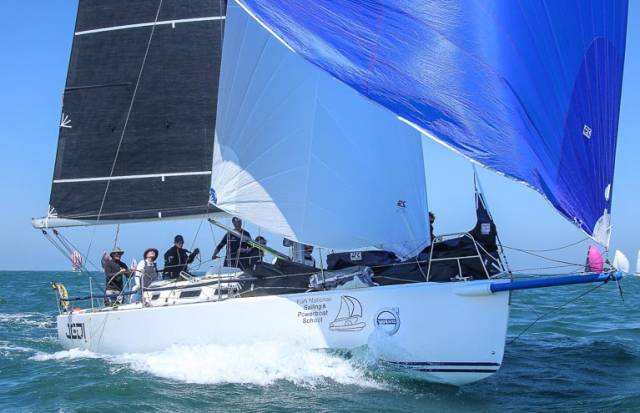 The INSS Jedi competing in the 2018 Round Ireland Race. Photo: Afloat.ie
The INSS Jedi competing in the 2018 Round Ireland Race. Photo: Afloat.ie
Both describe in detail the key points they think lead to the successful recovery of John, proper preparation, pre-sailing drills, sufficient training for all the crew and ultimately having the right gear, as well as knowing how to use it.
White describes the surreal experience of being away from the boat, and the exemplary Seamanship exploits undertaken to retrieve him safely, and indeed get back racing. Rumball shares his experiences as Skipper but emphasises how the training he provides in the day job as chief instructor at the Irish National Sailing & Powerboat School kicked in. A frank and sobering discussion on the good fortune it was to correctly install AIS MOB devices, ensure that everyone had the latest lifesaving kit is undertaken.
This is a must-watch for any skipper or crew member who races offshore but would appeal to a wider audience with an interest in yachting as John and Kenneth recant the compelling story, which thankfully had a happy outcome.
The video (above) is divided into chapters as follows:
- Preparation - 2 mins 30 seconds
- Build Up - 14 mins 20 seconds
- Man Overboard - 20 mins 20 second
- The water - 30mins 20 seconds
- Gear - 34 mins 40 seconds
- Recovery - 51 mins 00 seconds
- Rest of the Race - 1 hour 10 mins 40 seconds
Quarterdeck & INSS Partner to Support Irish Sailors Aiming to Join the Marine Industry
The Irish National Sailing & Powerboat School have just teamed up with Quarterdeck & The Yacht Week to provide Irish sailors with a gateway to become skippers and hosts and enter the world of working in the yacht charter industry.
What is Quarterdeck?
Quarterdeck is the recruitment agency for skippers and hosts worldwide. They provide a tailored Academy that polishes your current skills in order to work with their exclusive partner The Yacht Week along with several other private charter partners in destinations such as Croatia, Greece, Montenegro, British Virgin Islands and many more.
What is The Yacht Week?
“The Best Job In The World!” The Yacht Week is known as a flotilla festival, where skippers and hosts can develop their charter skills while working in a friendly environment, with a community that is there to support and help them grow.
Take it to the next level and spend a summer working at The Yacht Week. Meet friends from all over the world and be part of a truly international team. Skipper for a crew of 10 on a yacht in Croatia, Greece or Montenegro, while being a part of The Yacht Week flotilla of up to 100 yachts per week. Make lasting friendships with people from all over the world and get paid to do it. Whether you are looking to work for a couple of weeks or the entire summer, Quarterdeck wants you!
As a skipper or host for QD you are working on yachts with 6-10 guests onboard. The skipper and host are tasked with making the week exceptional for their guests while keeping them safe.
How does it work?
- Apply for Quarterdeck academy
- Get the required licences. As a partner school of Quarterdeck, the INSS is a recommended choice. The instructors are familiar with the Quarterdeck’s training programme so are the best suited for preparing you for the academy.
- Attend the weeklong Quarterdeck Academy (five weeks to choose from in April or May).
- After passing the academy, Irish sailors are officially part of the team and can now work for The Yacht Week (June, July, August).
Skipper Requirements?
- Recognised skipper licence (ideally RYA Yachtmaster)
- VHF licence
- First Aid Certificate
- A love for sailing
Questions?
Getting an RYA Licence
Contact the Irish National Sailing & Powerboat School by email [email protected] or call 01 2844195.
Joining Quarterdeck Academy
The Academy applications are now open for Spring of 2020. Interested sailors should email [email protected] for any queries.
What is the Irish National Sailing School Doing Now?
What is the Irish National Sailing School at Dun Laoghaire Harbour up to now? The answer to that question is: "We're off to film Iceland", School Principal Alistair Rumball told Afloat as his film services division was packed on to trailers this week.
The intrepid Dublin sailing school and film services company have a much sought after marine expertise and that means the INSS crew are often travelling far and wide with plenty of equipment including RIBS, trailers and props such as Viking ships.
Rumball wouldn't be drawn on the name of the next blockbuster, such is the level of confidentiality on these matters, but he did tell Afloat the INSS is heading to Reykjavik on a special assignment.
Rumball has developed a busy marine services division for film and television, with titles such as “Saving Private Ryan”, “Robin Hood”, “PS I Love You” and “The Guard” part of the INSS show reel.
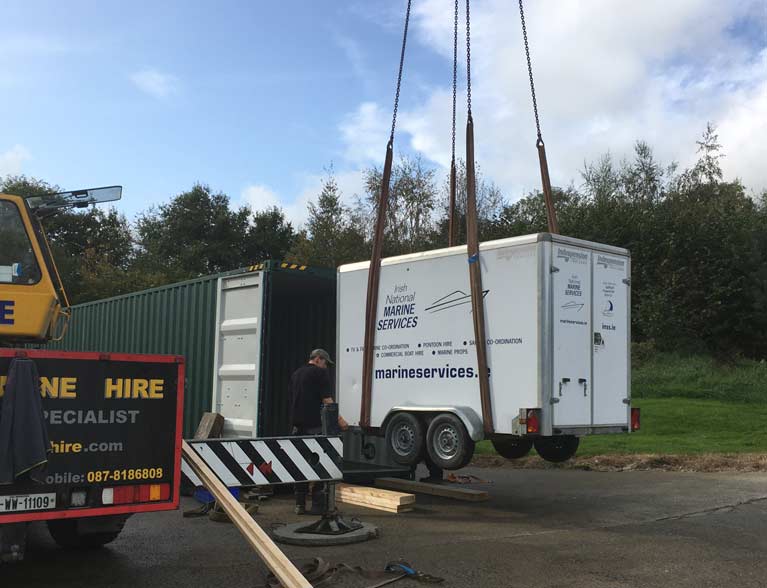 The INSS trailer
The INSS trailer
The largest and most recent project was the TV series “Vikings” filmed in Ireland at locations including Lugala, Loch Dan and off Wicklow head. Alistair not only provides marine co-ordination for up to 200 cast and crew on the water but also organises all the logistics of getting countless craft, including 50ft Viking Ships, onto location.
Check out a few of the videos for a flavour of this work here
Irish National Sailing & Powerboat School Welcomes 60 International Skippers for Weekend of Racing
Last weekend over 60 international skippers and boaters were welcomed to the Irish National Sailing & Powerboat School at Dun Laoghaire Harbour.
The West Pier venue hosted Quarterdeck Academy’s annual Skipper and Host Regatta, which saw close, lively and enjoyable racing from Dun Laoghaire aboard twelve 1720s. Crews comprised people from all over the globe, with the many European countries, the United States, Canada and South Africa particularly well represented.
Racing commenced on Sunday morning and Race Officer Kenneth Rumball got five races in for the day. Racing was facilitated by teamwork from a variety of Dun Laoghaire sailing establishments, with INSS boats, joined by RIYC and RSGYC fleets. This close cooperation happens every week of the Summer months, and it is a testament to all these organisations committed to facilitating participation on the bay.
Check out a video of the racing action…
Monday’s programme was lost to 35-40 knot gusts, however, the international guests more used to Sunnier climes of Croatia, Greece and the British Virgin Island took to the water to experience and Irish Sea South Easterly in the school’s fleet of large passenger RIBs.
Chief Instructor Kenneth Rumball was thrilled to see so many familiar faces, both former instructors in the school now making a living in the marine industry as well as graduates of the school’s yachting courses. “The weekend was particularly rewarding, seeing skills and training put to use. This is what the school is all about, allowing people to live out their boating dreams”.
In total, over 100 Quarterdeck Academy members spent a long weekend in Dublin, with the itinerary including a trip to the Guinness Storehouse on Saturday, Dinner in the CHQ on Sunday evening, and plenty of time to sample the Dublin nightlife too. The draw for all of this tourist group was well organised and fun racing on the ideal training ground of Dublin Bay – drawing over 200 bed nights on the weekend alone. Both why come to Ireland for a weekend, when you can tour the country for the rest of the week? One Irish Skipper turned tour guide, encouraged a large crew to travel the length and breadth of the country seeing all it is Ireland has to offer, after of course, seeing what in the school’s humble opinion is Ireland’s best offering, it's sailing!
The event has served as an excellent trial run for this style of activity, and plans are already afoot to build on the success of the weekend with a similar programme tailored to introducing more people to racing on Dublin Bay.
The Irish National Sailing School (INSS) is seeking a full-time Instructor and co-ordinator. The successful candidate will also provide coordination assistance for the operation of a busy watersports centre.
Role Description
- Role: Full Time Sailing Instructor / Operations Coordinator
- Duration: 1-year contract starting immediately
- Salary: Based on Experience
- Hours: Wednesday to Sunday from September to May, Monday to Friday from June to August. Some flexibility is required.
- Role Pre-requisites and Training Scope
- Irish Sailing/RYA Dinghy Instructor Certificate
- Irish Sailing/RYA Powerboat Level 2 Certificate
- Applications are also welcome for candidates who hold senior instructor qualifications.
The school is also happy to take on a candidate with a dinghy instructor qualification, who will be mentored by a team of experienced senior instructors with a view to undertaking a senior instructor qualification during the contract.
Additional training in all aspects of boating may be made available with significant potential for advancement in the marine sector.
Applications
All parties with interest should send their CV to [email protected], using the reference "Full Time Sailing Instructor / Operations Coordinator" in the subject title. Interviews will be happening immediately.
170 Try Sailing, Kayaking & Paddleboarding at Irish National Sailing & Powerboat School
170 adults and children took to the waters of Dun Laoghaire Harbour and Dublin Bay last Sunday 5th May to try sailing, kayaking and paddleboarding at the Irish National Sailing & Powerboat School Open Day.
New sailors got to grips with the schools 1720 fleet exploring the bay while kayakers and paddleboarders traversed the sheltered inner harbour areas. The school held its annual open day in partnership with the Irish National Sailing Club, established to allow graduates of the courses to continue sailing in a relaxed and friendly manner. Many club members joined sailors out on the various boats, sharing information about a simple continuous pathway for the new sailor to follow from an introductory course through to regular participant.
"The model developed by the school and club has proved successful in getting adults who have never sailed before to become regular sailors"
The model developed by the school and club has proved successful in getting adults who have never sailed before to become regular sailors. This was on show in force and everyone is hopeful for new this year's latest batch of new regular sailors to come from the initiative.
Speaking about the event Glyn Williams, Marketing & Communications Manager from the INSS was delighted with attendance. “With 170 people out enjoying Dun Laoghaire Harbour and Dublin Bay, we’ve had our busiest open day ever. It was brilliant to see so many people meeting instructors from the school and INSC members, who were in the exact same place as them recently”.
All participants will now be encouraged to keep up their newfound skill, with the objective to have a new group of regular water users out before the end of the Summer.
“We’ve reoriented all our programmes to provide the most simple and streamlined route for both adults and children to become regular participants on the water. We’ve had no choice but to respond to potential sailors needs, and that’s the secret of the success”.
INSS Announce RS Sailing Craft Demo Day
Irish National Marine Services have announced a demonstration day of RS Sailing craft on Sunday 28th April at the Irish National Sailing & Powerboat School in Dun Laoghaire. Included in the line up will be the new RS21 keelboat, with opportunities to get sailing on this exciting design.
There’ll also be a selection of RS Sailing’s training fleet of RS Quests and RS Zests. A demo RS Aero will also be on the water for trials.
"Included in the line up will be the new RS21 keelboat"
The Irish National Sailing & Powerboat School’s office will manage bookings for time slots to ensure everyone gets out on their chosen boat for a test sail of between an hour and an hour and a half. Full changing and clubhouse facilities will be provided by the INSS ashore, and the RS Sailing Agent Kenneth Rumball will be afloat to chat about the boats and help out with the demos.
Irish National Marine Services are looking forward to welcoming all on the 28th of April.
Enquiries about time slots to 01 2844195 or email [email protected]



























